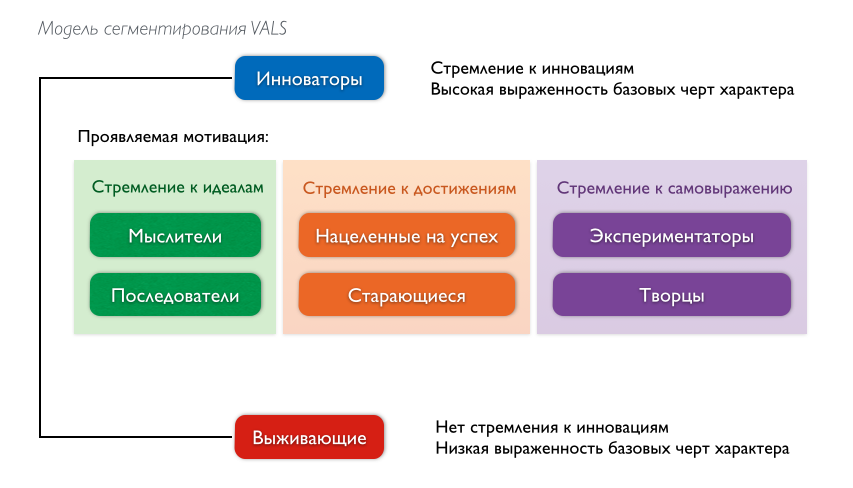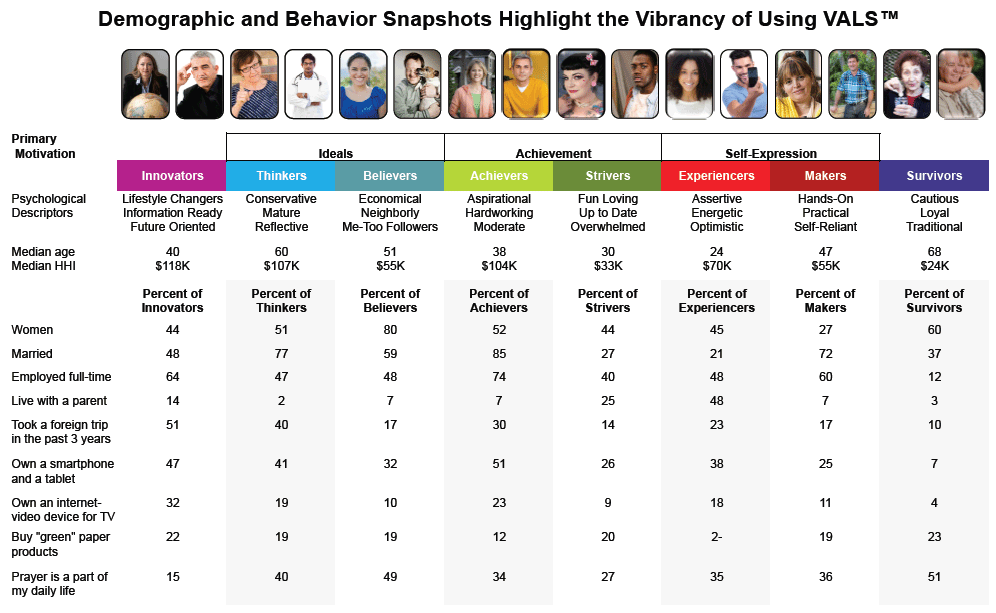How to segment the target audience using psychographics?
To sell a product, you need to know exactly the characteristics of the target audience and its preferences. There is a special approach to segmenting the target audience. This is psychography. It helps to divide consumers into groups, taking into account common motives of behavior, life values and attitudes.
If you take into account the lifestyle of typical representatives of the target audience, then you can create an interesting advertising campaign , taking into account all the factors of influence. Psychography allows you to get information about the core values and prevailing character traits of a potential buyer, which means you can better understand the main selection criteria, the importance of a particular product group, and also make a choice in favor of certain media channels.
Psychographic segmentation according to the VALS model

The VALS model (Values and Lifestyles, that is, “values and lifestyle”) appeared in the United States in 1979 and is still considered a valuable marketing tool. It allows you to highlight the main motivation for purchases, as well as understand what resources potential customers need to make purchases. There are three groups of resources:
- Psychology: confidence, impulsiveness, openness, leadership;
- Economy: purchasing activity and income level;
- Demographics: level of education, status.
Depending on which aspirations are more expressed than others, 8 psychogroups are distinguished:
- Ideals are pursued by thinkers and followers;
- To achievements - successful and trying;
- To self-expression - practitioners and experimenters;
- To everything new - innovators;
- Survivors have little to no conscious aspirations.
The main groups of psychological segmentation according to the VALS model

Let us analyze in order what basic values and goals a potential representative of each of the psychogroups will have.
Innovators have the greatest amount of psychological resources. Most often they are very active and socially successful people with high self-esteem. They found startups, promote themselves as politicians. For very important novelty, uniqueness, innovation. They will rather emphasize originality and independence, but not status. Innovators buy a lot, always choosing unique quality (so-called "niche" products). Each purchase is not only a way to emphasize your own uniqueness, but also a new experience that is worth telling other people about. If an innovator is interested in your product, you can be sure that he will be happy to share his impressions about it with his friends on social networks. You can interest such people with a novelty through educational, information, news portals, but not through TV.

Thinkers are reasonable, and their motivation is based primarily on beliefs. They value orderliness, logical construction, strive to keep abreast of the latest news. They are attracted to everything that you can think of. At the same time, thinkers are quite conservative and respect traditions. They will carefully analyze how the quality and functionality of the acquisition correspond to the price category of the thing. They always look at reviews, study test results, compare.
Followers are considered to be an even more conservative group. They follow the norms established in society, trust them, and prefer stability. Often they can be found in religious or public organizations. Before making a purchase, such people will be interested in the opinion of the environment. They most often choose brands and brands that are well-known, and then they are best suited for television advertising.

Successful people are motivated by achievement. They always have a clear goal, and often this is a new step on the way to the top of their career. Also, these people like to demonstrate their status and their position in society. They have a clear plan of action, and when choosing, they are guided by authorities. The successful are characterized by high consumer activity, while they more often choose brands and things that are considered prestigious in their environment. They watch TV, actively communicate in social networks and follow the news. They spend often and a lot, while choosing products that save time. Ideal target audience for almost any product!
But for the fashion and entertainment industry, there is an even more desirable target audience. These are the ones who try . They strive for success and follow trends, often guided by the opinions of others, but do not pursue a career. These are beauty bloggers and other fashion followers who always choose the most stylish things and expensive logos. They spend a lot on cosmetics, clothes and try their best to impress.

But experimenters are driven by self-expression. They easily try new things, but just as easily lose interest in new things. They are always looking for new values, they choose young brands and prefer outdoor activities. They are used to making purchases impulsively and are happy to learn about new products in social networks.

Practitioners always choose mundane things. Most often they work hard and achieve a lot. They can be attracted by goods within the standard range of interests - leisure, work, family. Luxury items seem unreasonably expensive to them.

Survivors are the most limited in resources . They are very passive and tend to give up desires for the sake of "security". Trust discounts, read the yellow press.
Now you know how else you can classify leads. Such an acquaintance with psychographic types, even if superficial, will help you better segment your target audience, which means more sales.
